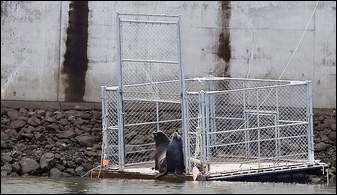forum
library
tutorial
contact

What To Do About
These Dam Sea Lions
by Phil FerolitoYakima Herald-Republic, March 25, 2008
|
the film forum library tutorial contact |

|
What To Do About
by Phil Ferolito |
Note the rope in the photo
 BONNEVILLE DAM - State and tribal authorities were out in force Monday trying to drive away a growing number of California sea lions from an anticipated large spring chinook run this year.
BONNEVILLE DAM - State and tribal authorities were out in force Monday trying to drive away a growing number of California sea lions from an anticipated large spring chinook run this year.
The past five years, both tribal and commercial fishermen have been frustrated by more and more sea lions gathering below Bonneville Dam, feasting on salmon and steelhead trying to make their way past fish ladders.
Loud pops echoed across the Columbia River Gorge as crews from the Columbia River Inter-Tribal Fish Commission and the Washington Department of Fish and Wildlife fired underwater firecrackers from a 12-gauge shotgun into the river near the large mammals in an effort to scare them out of the area.
One sea lion could be seen near the boat launch swimming with a fish in its mouth as the heads of other sea lions surfaced in the water.
Two Washington congressmen, Reps. Doc Hastings, R-Wash., and Brian Baird, D-Wash., who had been invited to view the problem firsthand, were surprised at what they saw.
"We had already seen a few (fish) get eaten (by sea lions) after just being out there a few minutes," Baird said after getting off a boat tour given by the Inter-Tribal commission.
"And this is only the beginning of the run," Hastings chimed in.
State and tribal authorities have been conducting this form of hazing of sea lions the past few years with little success. The hazing costs $250,000 annually, an amount both Hastings and Baird would like to plow back into salmon recovery programs.
Last week, federal authorities approved a measure that will allow state and tribal authorities to lethally remove each year up to 85 sea lions, which are threatening endangered fish runs. Sea lions are protected under the federal Marine Mammal Act.
But getting federal approval for lethal removal was a lengthy process and only covers a few years, something that both Hastings and Baird are trying avoid in the future.
And on Monday, the Humane Society of the United States, Wild Fish Conservancy and two citizens filed suit in U.S. District Court to halt the authorized killing of sea lions at the base of the dam.
Tribal and nontribal fishermen have complained about the sea lions affecting their fisheries, while biologists have worried about impacts to endangered fish. Meanwhile, the California sea lion population continues to grow, increasing from only about 10,000 in the 1950s to more than 300,000 today. An average 600-pound male often consumes up to 14 percent of its body weight in food every day, or roughly 85 pounds.
With a record run of more than 260,000 spring salmon expected to return this year, state and tribal authorities want to assure fishermen they will receive their share of the run. The run of spring chinook is bound for the Upper Columbia.
Four Columbia River tribes - Yakama, Nez Perce, Umatilla and Warm Springs - consider salmon sacred and rely on the fish for many traditional ceremonies, such as feasts, funerals and memorials.
"It's very important for us to have that salmon on hand all the time," said Inter-Tribal Chairwoman and Yakama Tribal Councilwoman Fidelia Andy. "It's our life."
Now, Hastings and Baird are looking at legislation that would give the secretary of commerce the authority to authorize the lethal taking of nuisance sea lions below the dam, a move that would streamline the process.
But nobody is rushing to kill sea lions, Inter-Tribal fish biologist John Whiteaker said.
Sea lions are now being tracked, marked and moved. A trap sits near the dam, and sea lions are being moved as far away as Newport, Ore., he said.
Only sea lions that have repeatedly returned to the area would be considered for lethal removal. And with those, alternative homes would be sought before they would be killed, he said.
Homes at marine parks across the country have already been found for such sea lions, he added.
Having lawmakers visit the area hopefully will help bring some long-term solutions to the problem, Andy said.
"They've seen it today for themselves and I'm glad," she said. "We've been talking about this for a long time."
learn more on topics covered in the film
see the video
read the script
learn the songs
discussion forum
